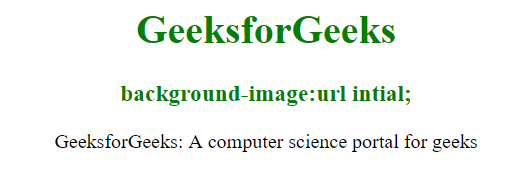CSS background-image Property
Last Updated :
14 Jan, 2024
The background-image Property is used to set one or more background images for an element. By default, it places the image in the top left corner. To specify two or more images, we need to specify the separate URLs with a comma for both images.
Syntax
background-image: url('url')|none|initial|inherit;
Property Values
|
url(‘url’)
|
This specifies the URL of the image. To specify the URL of more than one image then separate the URLs using a comma.
|
|
nope
|
This is the default case where no image can be displayed.
|
|
initial
|
It is used to set the property to its default value.
|
|
inherit
|
It inherits the property from its parent element.
|
The background-image property can also be used with the following values:
|
linear-gradient()
|
It is used to set the linear-gradient background-image that is defined at least 2 color from top to bottom.
|
|
radial-gradient()
|
It is used to set the radial-gradient background-image that is defined at least 2 color from center to edge.
|
Example 1: This example illustrates the background-image property by setting the url value as url.
HTML
<!DOCTYPE html>
<html>
<head>
<title>background-image property</title>
<style>
body {
background-image: url(
}
h1,
h3 {
color: green;
}
body {
text-align: center;
}
</style>
</head>
<body>
<h1>GeeksforGeeks</h1>
<h3>background-image:url;</h3>
<div>
GeeksforGeeks: A computer science portal for geeks
</div>
</body>
</html>
|
Output:

Example 2: This example illustrates the background-image property by setting the url value as none.
HTML
<!DOCTYPE html>
<html>
<head>
<title>background-image property</title>
<style>
body {
background-image: url(
}
h1,
h3 {
color: green;
}
body {
text-align: center;
}
</style>
</head>
<body>
<h1>GeeksforGeeks</h1>
<h3>background-image:url none;</h3>
<div>
GeeksforGeeks: A computer science portal for geeks
</div>
</body>
</html>
|
Output:

Example 3: This example illustrates the background-image property by setting the url value as initial.
HTML
<!DOCTYPE html>
<html>
<head>
<title>CSS background-image property</title>
<style>
body {
background-image: url(
}
h1, h3 {
color: green;
}
body {
text-align: center;
}
</style>
</head>
<body>
<h1>GeeksforGeeks</h1>
<h3>CSS background-image:url initial;</h3>
</body>
</html>
|
Output:

DOM background Image Property
The HTML DOM Style backgroundImage Property can be used to set or return the background image of an element.
Supported Browsers
The browser supported by background-image Property are listed below:
- Google Chrome 1.0
- Microsoft Edge 12.0
- Firefox 1.0
- Opera 3.5
- Safari 1.0
Share your thoughts in the comments
Please Login to comment...